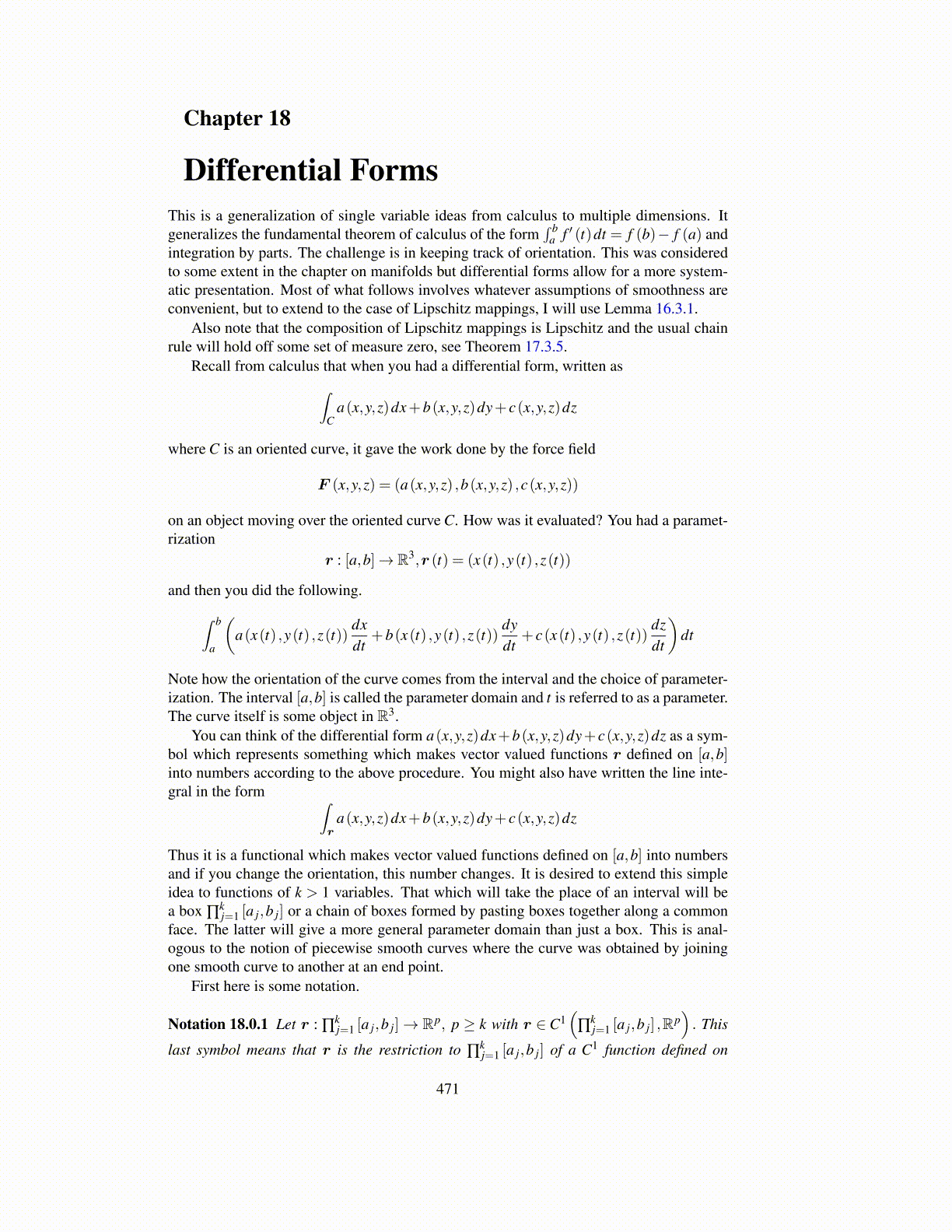
Chapter 18
Differential FormsThis is a generalization of single variable ideas from calculus to multiple dimensions. Itgeneralizes the fundamental theorem of calculus of the form
∫ ba f ′ (t)dt = f (b)− f (a) and
integration by parts. The challenge is in keeping track of orientation. This was consideredto some extent in the chapter on manifolds but differential forms allow for a more system-atic presentation. Most of what follows involves whatever assumptions of smoothness areconvenient, but to extend to the case of Lipschitz mappings, I will use Lemma 16.3.1.
Also note that the composition of Lipschitz mappings is Lipschitz and the usual chainrule will hold off some set of measure zero, see Theorem 17.3.5.
Recall from calculus that when you had a differential form, written as∫C
a(x,y,z)dx+b(x,y,z)dy+ c(x,y,z)dz
where C is an oriented curve, it gave the work done by the force field
F (x,y,z) = (a(x,y,z) ,b(x,y,z) ,c(x,y,z))
on an object moving over the oriented curve C. How was it evaluated? You had a paramet-rization
r : [a,b]→ R3,r (t) = (x(t) ,y(t) ,z(t))
and then you did the following.∫ b
a
(a(x(t) ,y(t) ,z(t))
dxdt
+b(x(t) ,y(t) ,z(t))dydt
+ c(x(t) ,y(t) ,z(t))dzdt
)dt
Note how the orientation of the curve comes from the interval and the choice of parameter-ization. The interval [a,b] is called the parameter domain and t is referred to as a parameter.The curve itself is some object in R3.
You can think of the differential form a(x,y,z)dx+b(x,y,z)dy+c(x,y,z)dz as a sym-bol which represents something which makes vector valued functions r defined on [a,b]into numbers according to the above procedure. You might also have written the line inte-gral in the form ∫
ra(x,y,z)dx+b(x,y,z)dy+ c(x,y,z)dz
Thus it is a functional which makes vector valued functions defined on [a,b] into numbersand if you change the orientation, this number changes. It is desired to extend this simpleidea to functions of k > 1 variables. That which will take the place of an interval will bea box ∏
kj=1 [a j,b j] or a chain of boxes formed by pasting boxes together along a common
face. The latter will give a more general parameter domain than just a box. This is anal-ogous to the notion of piecewise smooth curves where the curve was obtained by joiningone smooth curve to another at an end point.
First here is some notation.
Notation 18.0.1 Let r : ∏kj=1 [a j,b j]→ Rp, p ≥ k with r ∈ C1
(∏
kj=1 [a j,b j] ,Rp
). This
last symbol means that r is the restriction to ∏kj=1 [a j,b j] of a C1 function defined on
471